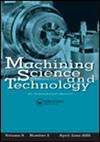Drilling of titanium alloy (Ti6Al4V) – a review
IF 2.6
4区 工程技术
Q2 ENGINEERING, MANUFACTURING
引用次数: 22
Abstract
Abstract In recent years, demand of titanium alloy (Ti6Al4V) in various industries especially aerospace industries drastically increased. Several exceptional properties of titanium alloy that contribute to its popularity include high compressive and tensile strength, fracture toughness oxidation resistance and high strength-to-weight ratio. However, due to these superior properties, titanium alloys are categorized as hard-to-machine materials. The drilling process is accounted for roughly 40%−60% of material removal processes of an aeronautical product. Drilling processes for titanium alloys are categorized into conventional method (twist drilling) and unconventional method (rotary ultrasonic machining [RUM] drilling, laser drilling and electron discharge machining [EDM] drilling). This research aims to identify mechanisms and limitations of each drilling method applicable on titanium alloys. In addition, processing parameters affecting performance measures of each drilling method are discussed. The main problem associated with conventional twist drilling is extreme processing temperature, resulting in rapid tool wear and extensive burrs formation. These issues cause the cost for titanium alloy drilling to be relatively high as compared with twist drilling of other materials. To minimize these issues, researchers have developed several unconventional drilling methods, aiming to minimize issues found in conventional twist drilling.钛合金(Ti6Al4V)的钻削研究进展
近年来,各行业特别是航空航天工业对钛合金(Ti6Al4V)的需求量急剧增加。钛合金的一些特殊性能,包括高抗压和抗拉强度,断裂韧性,抗氧化性和高强度重量比,有助于其受欢迎。然而,由于这些优越的性能,钛合金被归类为难以加工的材料。钻削工艺约占航空产品材料去除工艺的40% ~ 60%。钛合金的钻孔工艺分为常规方法(麻花钻孔)和非常规方法(旋转超声加工[RUM]钻孔、激光钻孔和电火花加工[EDM]钻孔)。本研究旨在确定适用于钛合金的每种钻孔方法的机理和局限性。此外,还讨论了工艺参数对各种钻孔方法性能指标的影响。传统麻花钻的主要问题是极端的加工温度,导致工具快速磨损和大量毛刺的形成。这些问题导致钛合金的钻削成本相对于其他材料的麻花钻削成本较高。为了最大限度地减少这些问题,研究人员开发了几种非常规钻井方法,旨在最大限度地减少传统麻花钻井中出现的问题。
本文章由计算机程序翻译,如有差异,请以英文原文为准。
求助全文
约1分钟内获得全文
求助全文
来源期刊

Machining Science and Technology
工程技术-材料科学:综合
CiteScore
5.70
自引率
3.70%
发文量
18
审稿时长
6 months
期刊介绍:
Machining Science and Technology publishes original scientific and technical papers and review articles on topics related to traditional and nontraditional machining processes performed on all materials—metals and advanced alloys, polymers, ceramics, composites, and biomaterials.
Topics covered include:
-machining performance of all materials, including lightweight materials-
coated and special cutting tools: design and machining performance evaluation-
predictive models for machining performance and optimization, including machining dynamics-
measurement and analysis of machined surfaces-
sustainable machining: dry, near-dry, or Minimum Quantity Lubrication (MQL) and cryogenic machining processes
precision and micro/nano machining-
design and implementation of in-process sensors for monitoring and control of machining performance-
surface integrity in machining processes, including detection and characterization of machining damage-
new and advanced abrasive machining processes: design and performance analysis-
cutting fluids and special coolants/lubricants-
nontraditional and hybrid machining processes, including EDM, ECM, laser and plasma-assisted machining, waterjet and abrasive waterjet machining
 求助内容:
求助内容: 应助结果提醒方式:
应助结果提醒方式:


